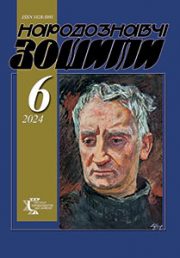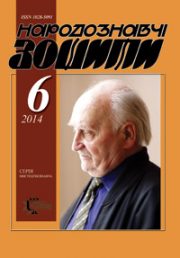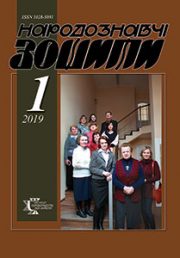The Ethnology Notebooks. 2017, 6 (138), 1459—1467
UDK 7. 046; 7.041.6
DOI https://doi.org/10.15407/nz2017.06.1459
Received 7.11.2017
ORCID ID: https://orcid.org/0000-0002-1202-1488
Kosiv Roksolana Romanivna, Ph.D. in Art Studies,
senior researcher at the Department of Old-Ukrainian Art
of the National Museum in Lviv named after Andrey Sheptytsky,
associate professor at the Department of Sacral Art
of the Lviv National Academy of Arts,
Kubiiovycha Str., 38, Lviv, 79011, Ukraine.
Contacts: Tel. (032) 2761482; e-mail: lanakosiv@yahoo.com
Abstract. The article is devoted to the review of miraculous icons painted in the style of masters of the Rybotychi cell. Among them an icon of the Mother of God Lisskoy is excreted, the features of her iconography were traced and other works, painted by the same master, were found. On the basis of the dated icon of this author, the dating of the icon of the Mother of God of Liska was specified in the 1680s and early 1660s. The replica of the miraculous icon of the Theotokos of Terebovlia, performed by the rybotychi master of Ivan Seredynskyi is specified, and the dating of this copy was specified in 1710—1717s. The influence of the iconography of the miraculous icons of the Diocese of Peremysk, in particular the Virgin of Lopianska, Verkhatska, and Khlopytska, was noted on separate models of the Virgin Mary of Eleusa in the performance of the rybotychi painters. In the context of the miraculous icons of the rybotychi masters, the icon of the Virgin of Odigitria of the late XVII century In the context of the miraculous icons of the riteatic masters, the icon of the Virgin of Odigitria of the late XVII centuries from the Church of the Protection of the Virgin in Buchach is considered.
Keywords: miraculous icons of the Virgin, rybotychi painting center (1680—1720s), iconography, artistic features.
REFERENCES
Greshlyk, V. (2004). Tserkva Stritennia Hospodn’oho v seli Koziany (Koћany) poblyzu Bardiieva (dekil’ka prymitok do ii ikon, ikonostasa ta nastinnoho rozpysu j hraviur). In Zachodnioukrainska sztuka cerkiewna. V. II. Materialy z miedzynarodowej konferencji naukowej 10—11 kwietnia 2004 roku Lancut — Kotas— lancut (pp. 316—325). Lancut: Muzeum-Zamek w Lancucie. [in Ukrainian]
Kosiv, R. (2011). Ikony «Pokrov Bohorodytsi» ta «Bohorodytsia Zamyluvannia» 1680—1691 rokiv z tserkvy v Lopushantsi Lekhnovij na L’vivschyni. Litopys Natsional’noho muzeiu u L’vovi im. Andreia Sheptyts’koho, 8 (13), 107—118.[in Ukrainian]
Kosiv, R. (2012). Maliars’ka spadschyna majstra Ivana Seredys’koho z Rybotych. Apolohet. Khrystyians’ka sakral’na tradytsiia: vira, dukhovnist’, mystetstvo. Bohoslovs’kyj zbirnyk L’vivs’koi dukhovnoi seminarii, 32—33, 112—120. [in Ukrainian]
Miliaieva, L. (1994). Chudotvorni ikony Bohorodytsi v Kyievi XVII stolittia ta obraz Liubets’koi Bohomateri penzlia Ivana Schyrs’koho. Zapysky Naukovoho tovarystva im. Shevchenka u L’vovi. Pratsi Sektsii mystetstvoznavstva, 227, 124—140. [in Ukrainian]
Pushkash, B. (2003). Mariia Povchans’ka i chudotvorni obrazy karpats’koho rehionu. In Zachodnioukrainska sztuka cerkiewna: Dzieia, tworcy, osrodki, techniki. Materialy z miedzynarodowej konferencji naukowej 10—11 maja 2003 roku (pp. 253—271). Lancut : Muzeum-Zamek w Lancucie. [in Ukrainian]
Ukrains’kyj ikonopys XII—XIX st. z kolektsii NKhMU. (2004). Kyiv : Halereia. [in Ukrainian]
Biskupski, R. (2003). O dwu wariantach przedstawiania Matki Boskiej Eleusy w sztuce ukrainskiej XVII—XIX wieku. In Zachodnioukrainska sztuka cerkiewna. Dzieіa tworcy osrodki techniki. Materialy z miedzynarodowej konferencji naukowej 10—11 maja 2003 roku (pp. 272—287). Lancut : Muzeum-Zamek w Lancucie. [in Polish]
Fridrich, A. (1904). Historye cudownych obrazow Najswietszej Maryi Panny w Polsce (Vol. 2). Krakow. [in Polish]
Giemza, J. (2013). Dwustronna ikona procesyjna Bogurodzicy Hodigitrii i Swietego Mikolaja z 1500 roku, z cerkwi p. w. Narodzenia Bogurodzicy w Lesku (Posadzie Leskiej). Materialy Muzeum Budownictwa Ludowego w Sanoku, 38, 220—230. [in Polish]
Czajkowski, J., Grzadziela, R. & Szczepkowski, A. (Eds.). (1998). Ikona Karpacka. Album wystawy w Parku Etnograficznym w Sanoku. Sanok. [in Polish]
Janocha, M. (2008). Ikony w Polsce od Sredniowiecza do wspolczesnosci. Warszawa : Arkady. [in Polish]






